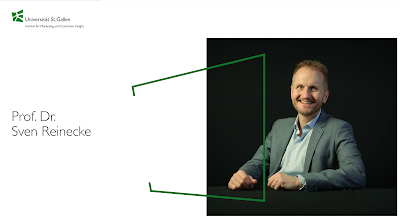Interview: Sven Reinecke, University of St. GallenProf. Dr. Sven Reinecke is Director of the Institute of Marketing & Customer Insight and Associate Professor at the University of St. Gallen (HSG). He is co-head of the Master in Marketing Management.How have Super Bowl commercials evolved over the years in terms of content, style, and impact on ...
Topics:
Acemaxx-Analytics considers the following as important:
This could be interesting, too:
investrends.ch writes Schweizer Firmen ziehen wieder Investitionen aus dem Ausland ab
investrends.ch writes Swisscanto CIO Survey: «Bullish bei Gold, gespalten bei KI-Aktien»
investrends.ch writes Parlamentariergruppe legt Kompromiss zu UBS-Kapitalregeln vor
investrends.ch writes Inflation in Deutschland hält sich hartnäckig über Zwei-Prozent-Marke
Interview: Sven Reinecke, University of St. Gallen
Prof. Dr. Sven Reinecke is Director of the Institute of Marketing & Customer Insight and Associate Professor at the University of St. Gallen (HSG). He is co-head of the Master in Marketing Management.
How have Super Bowl commercials evolved over the years in terms of content, style, and impact on consumer behavior?
The Super Bowl Commercials are basically an unofficial form of the "Oscars" in the advertising industry. The costs for both creation and placement have risen sharply: According to Statista, a 30-second commercial cost USD 7 million in 2023, twice as much as in 2010.
In general, it can be said that commercials have developed strongly in the direction of emotion, staging and storytelling in recent years.
Ultimately, they are short cinema films that are produced just as elaborately. This differs greatly from the classic product-related commercials of the past. Ultimately, the Super Bowl commercials can be seen as a mirror of US consumer culture.
 |
| Sven Reinecke, University St. Gallen, February 2024 |
How do advertisers measure the success of their Super Bowl commercials beyond traditional metrics like brand awareness and sales figures, and what new approaches are emerging in this area?
The measurement of advertising success always depends on the objective. If it is about awareness, then of course the "buzz in the community" and the media is important in order to multiply the very expensive advertising contacts. Of course, classic surveys are conducted on key figures such as active awareness, brand consideration and brand sympathy.
The number of online contacts and the level of engagement in the various online media (X, TikTok, Instagram, Facebook, Snapchat, YouTube, homepage, etc.) can also be measured during the broadcast. The topic of sales uplift is more difficult: a clear cause-and-effect relationship is not so easy here because sales depend on many other factors (distribution rate, weather, competitive measures, etc.).
In principle, however, it can be said that more and more online key figures are being collected - and fewer traditional attitude variables. In my view, however, the combination is important in order to understand the causes of purchasing behaviour and long-term effects.
Let us focus on the drivers of the recent inflation surge for a moment. Back in the 1970s, unit labor costs were the main driver of inflation. But more recently, unit profits have taken this role. How do you assess the empirical evidence that unit profits becoming a leading indicator of inflation in the context of “active price management”?
Of course, I am not an economist, but a business economist - so I cannot estimate the exact impact of business activities on inflation. But from a business management point of view, it is of course a matter of ensuring that companies remain profitable even in times of rising costs (purchasing, production, labor costs) by means of active price management.
As long as competition allows, such price increases can be enforced on the market. Some companies are much more successful in this respect than others.
Basically, however, I see a big difference in pricing between listed companies and traditional medium-sized companies ("Mittelstand"). In the growth - profitability - security triangle, the former focus on growth and profitability, while family-owned companies focus on security and profitability. The latter forgo growth if it is not profitable or if they cannot or do not want to finance it from their own resources. Thus, achieving higher prices is essential for them.
Thank you very much.
Sven Reinecke’s research and application focus on: strategic marketing, marketing performance management, pricing management and management decision behaviour.
